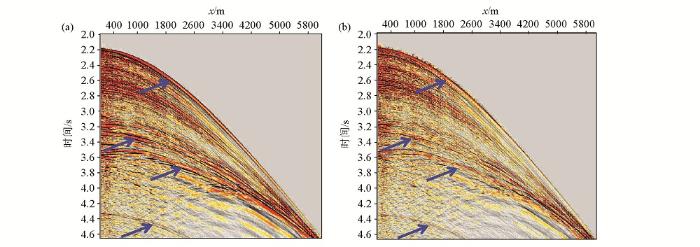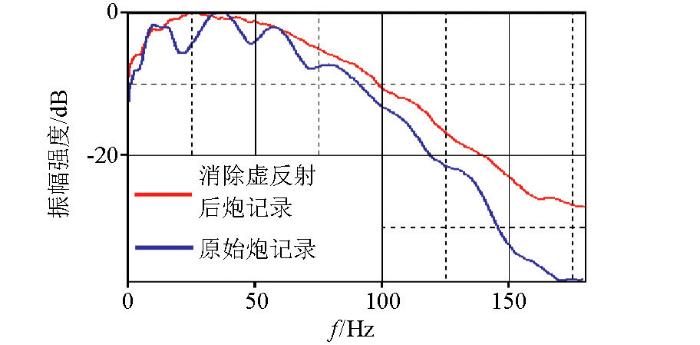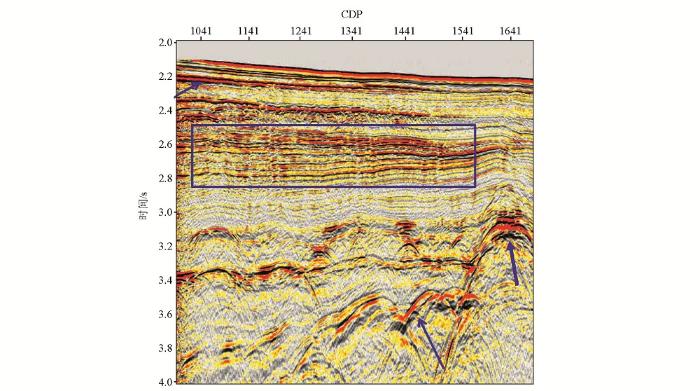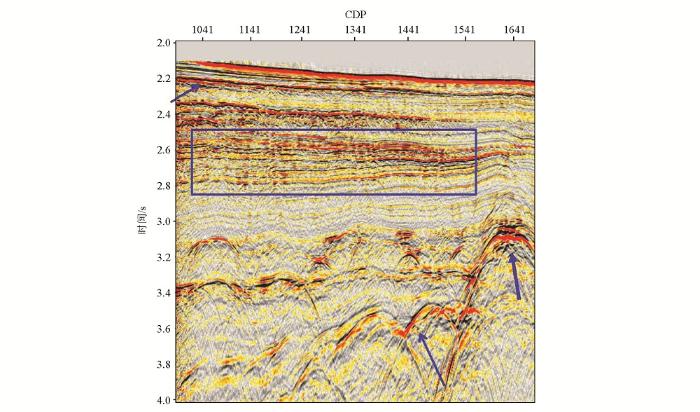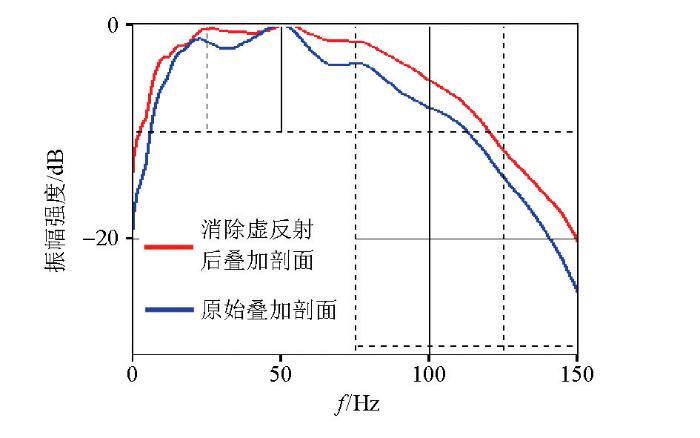0 引言
常规的拖缆采集中,拖缆的深度一般在5~10 m,这样的拖缆深度限制了有效信号的低频成分[1],并且由于近海水表层噪声太强使得接收到的信号信噪比较低。将拖缆沉放的深度增加有利于拓宽低频信号、减少噪声,但同时以牺牲高频为代价,这是由于检波器虚反射的第一个陷波频率造成的。
虚反射引起的频率陷波问题在震源和接收点都存在,对于震源虚反射引起的频率陷波通过采用多级不同深度的震源组合,然后通过延迟响炮的方式可有效消除虚反射的影响[2],而对于检波点虚反射引起的频率陷波,最早采用上下电缆的方法来克服[3,4,5],但这种方法采集成本过高;后来又在电缆的接收点压力检波器的基础上加上了速度检波器(对信号的传播方向敏感),即双检采集[6,7],不过这种技术对仪器性能要求很高;Robert等[8]提出的变深度电缆(即斜缆勘探)的采集方式,由于检波器的沉放深度影响着接收信号的有效频率,有效信号的低频和高频之间相互牵制,斜缆勘探中从最近的地震道开始,拖缆的深度随着炮检距的增大而变深,将拖缆保持在一个预定的目标深度,斜缆勘探中拖缆的深度可达60 m。
针对变深度电缆采集方式如何影响频谱,笔者做了较为详细的分析,尤其分析了斜缆采集能拓宽地震数据有效频带的机理及对中深层地质构造成像有利的低频信号强度,并通过模型正演分别对比了等深电缆和变深度电缆对地震道频谱的影响,再利用Poole[18]修改的线性最小平方Radon变换方程来消除虚反射产生的鬼波。正演模型和实际南海斜缆地震资料处理结果表明,去鬼波效果很好。
1 变深度电缆对频谱的影响分析
1.1 变深度电缆拓宽频率的机理分析
检波器虚反射的陷波频率与海水的速度c,检波器的深度d等因素有关,可用式(1)近似表示:
其中,fn表示沉放在d深度处检波器虚反射的第n个陷波频率。从公式分析可知,拖缆沉放越深,第一陷波频率越小,高频损失越严重。
在反射波垂直传播,即一维(1D)情形下
利用式(2)将不同深度检波器虚反射的频谱进行叠加得到式(3)
发现不同深度检波点之间的陷波点得到了相互补偿,低频和高频成分得到了拓展。式中:τ=
根据式(2),虚反射的振幅谱的函数是:
图1
即是振幅谱的导数。分析这个陡度函数发现在低频带尤其是1~12.5 Hz范围内,接受点越深,振幅谱越靠近振幅轴即接受到的信号低频成分越丰富,其原因是对于沉放深度是30 m的虚反射的振幅谱在12.5 Hz时信号达到峰值2(据公式4),图2截取了12.5 Hz以内的接受点深度分别是7.5、15、30 m的振幅谱曲线。
图2
在低频带取频率分别为2、3.5、5 Hz,并求解其振幅强度如表1所示。
表1
| 深度/m | 频率/Hz | ||
|---|---|---|---|
| 2 | 3.5 | 5 | |
| 7.5 | 0.1256 | 0.2195 | 0.3129 |
| 15 | 0.2507 | 0.4363 | 0.6180 |
| 30 | 0.4974 | 0.8516 | 1.1756 |
表2 沉放深度15、30与7.5 m振幅强度比较(分贝显示)
| 深度/m | 频率/Hz | ||
|---|---|---|---|
| 2 | 3.5 | 5 | |
| 15 | 6 dB | 5.97 dB | 5.91 dB |
| 30 | 11.95 dB | 11.78 dB | 11.50 dB |
综上可知,斜缆地震勘探有两个显著优势:①利用检波器虚反射陷波频点的不同,其叠加效果可拓宽频带和补偿陷频点能量;②检波点越深低频信号(小于5 Hz)的振幅越强。所以,采集到的地震资料信噪比较高、频带较宽,这是获取高信噪比、高分辨率、宽频带地震资料的基础和前提。
1.2 等深电缆和变深度电缆对地震道频谱的影响分析
通常虚反射产生的鬼波对一次波的影响主要跟它们之间的时差有关,当时差较小时,鬼波和一次波重叠在一起并因此改变了一次波的波形;当时差增大到半个周期时,鬼波对一次波的影响最大;当时差大于一个周期后,鬼波独立地跟在一次波之后形成尾巴。对于斜缆观测系统,由于检波器的深度随着偏移距的增加而变深,因此,鬼波和一次波的时差越来越大,表现在炮记录上为检波器鬼波与一次波逐渐分开。
图3是设计的速度模型,模型大小3 000 m(水平长度)×2 100 m(垂直深度),网格大小1 m×1 m。观测系统参数为:震源深度5 m,水平电缆缆深度15 m,斜缆深度15~67.37 m,接收点间距10 m。分别在水平缆和斜缆观测系统下进行波动方程正演模拟,进而研究其波场特征。
图3
图4
图5
图6
对于斜缆数据,也取第10、30、50道数据,进行频谱分析,结果如图7所示。
图7
由于斜缆中检波器深度随偏移距的增加而增加,使每一道数据的陷波点都不相同,各道数据第一陷波频率点逐渐向左移动,因此,将不同偏移距的频率进行叠加之后,各道数据的陷波点相互补偿,最终达到了增加有效频带宽度的效果(图8)。
图8
2 变深度电缆虚反射的消除方法
2.1 修改的线性最小平方Radon变换
已知的频率域τ-p变换是:
其中,L=
在斜缆勘探中需要对水平缆线性Radon变换的方程进行修改[18],由于斜缆数据中既存在一次波,也存在虚反射,因此,斜缆线性Radon变换的算子需要改写为两个部分:
其中:Lu=exp(-iwτpr),Ld=exp(-iwτgh)。
Lu表示一次波反变换算子,应用此算子可以得到电缆数据;Ld表示虚反射的反变换算子,应用此算子可以得到镜像电缆数据,τpr表示一次波的旅行时间,τgh表示虚反射的旅行时间。因此,可以利用这两个算子求解斜缆线性Radon变换的方程,从而得到海平面没有虚反射的数据。
其中:
θ表示射线角,vw是地震波在海水中的传播速度,检波点所在位置的炮检距是xn其对应的深度为zr,pm射线参数,Δhn,m表示斜缆中检波点与对应海平面上检波点的水平距离,Δτn,m表示斜缆一次波与虚反射相对于海平面接收的一次波的时差;τpr表示一次波的旅行时间,τgh表示虚反射的旅行时间。
图9
图10
2.2 消除斜缆虚反射的应用
2.2.1 正演模型测试
设计如图11的一个凹陷地质模型,模型大小4 201 m(水平长度)×6 100 m(垂直深度),网格大小1 m×1 m;采集参数参数是:震源深度5 m,检波点深度由4 m变化到48.6 m,最小炮检距125 m,道间距12.5 m,每炮240道,共300炮。
图11
图12
图13
图14
2.2.2 实际资料应用
以南海实际斜缆地震资料为例,该资料是深水资料,水深在1 500 m以上,资料信噪比较好,斜缆数据中一次波和虚反射在同相轴表现为随着炮检距的增加,二者时差也越来越大,该炮记录已进行了相应的去噪处理,但未做去多次波。
图15
图16
图17
图18
图19
3 结论
在反射波垂直传播即一维(1D)情形下,通过对变深度电缆的虚反射的频谱分析得出:①检波器沉放深度不同使得接收点的虚反射陷波频率点存在不同,其叠加结果会使频谱拓宽;②分析频谱曲线的陡度函数,沉放较深的检波点使得在低频端尤其小于5 Hz的低频信号的振幅强度显著增强。
与等深的水平缆产生的鬼波相比,斜缆采集方式使得虚反射引起的鬼波在中远道与一次波逐渐分离;正演模型和南海实际斜缆地震资料应用效果表明,采用修改的线性最小平方Radon变换方程(不同于水平缆的去鬼波方法)能够有效压制鬼波。
参考文献
Synchronized multi-level source and variable-depth streamer
[J].
Over/under towed-streamer acquisition:a metthod to extend seismic bandwidth to both higher and lower frequencies
[J].DOI:10.1190/1.2431831 URL [本文引用: 1]
利用上下缆合并算子确定海上上下缆采集的最优沉放深度组合
[J].
DOI:10.3969/j.issn.1000-1441.2013.06.010
URL
[本文引用: 1]

海上常规拖缆采集的地震数据存在受海水面虚反射(鬼波)引起的陷波特性,而近年发展的上/下缆采集技术可以压制鬼波,但仍然存在等效陷波。为此,提出了基于f-k域上/下缆合并算子确定上/下缆沉放深度的方法,进而分析了历年来国内外油公司采用的上/下缆沉放深度的合理性。针对目前国内拖缆沉放深度的最大范围,通过对不同上/下缆沉放深度下上/下缆合并算子的等效陷波特征分析,确定出等效陷波出现的频带范围在目的层有效频带范围以外的上/下缆最优沉放深度组合,系统优选出了12组上/下双缆以及3组上/中/下三缆陷波作用相对较小些的上/下缆沉放深度最优组合,为实际上/下缆采集时缆深选择提供了理论依据。
Over/under acquisition and data processing: the next quantum leap in seismic technology
[J].
DOI:10.3109/19401736.2015.1137903
URL
[本文引用: 1]

David Hill, Leendert Combee, and John Bacon, WesternGeco, introduce a new configuration for towed-streamer seismic data acquisition. They argue that the ver/under technique is a major advance on conventional techniques providing previously unattained signal bandwidth, where the low-frequency content gives deeper penetration, and therefore, improved imaging beneath basalt, salt, and other highly absorptive overburdens. In a conventional towed-streamer marine acquisition configuration, shallow sources and shallow cables increase the high-frequency content of the seismic data needed for resolution. However, shallow sources and shallow cables attenuate the low frequencies, which are necessary for stratigraphic and structural inversion, and for imaging deep objectives. Towing shallow also makes the data more susceptible to environmental noise. In contrast deep sources and deep cables enhance the low frequencies, but attenuate the high frequencies. In addition, the data recorded via a deep tow have a higher signal-to-ambient-noise ratio due to the more benign towing environment. A conventional towed-streamer survey design therefore, attempts to balance these conflicting aspects to arrive at a tow depth for the sources and cables that optimizes the bandwidth and signal-to-noise ratio of the data for a specific target depth or two-way travel time, often at the expense of other shallower or deeper objectives. An over/under, towed-streamer configuration is a method of acquiring seismic data where cables are typically towed in pairs at two different cable depths, with one cable vertically above the other. The depths of these paired cables are typically significantly deeper than would be used for a conventional towed-streamer configuration. In conjunction with these paired cables, it is possible to acquire data with paired sources at two differing source depths. Again, the depths of these paired sources are typically significantly deeper than would be used for a conventional towed-streamer configuration. The seismic data recorded by the over/under towed-streamer configuration are combined in data processing into a single dataset that has the high-frequency characteristics of conventional data recorded at a shallow towing depth and the lowfrequency characteristics of conventional data recorded at a deeper towing depth. This combination process is commonly referred to in the geophysical literature as deghosting. The current benefits of over/under data compared with conventional data can be summarized as: - A significantly broader signal bandwidth, where the lowfrequency content gives deeper penetration, and therefore, improved imaging beneath basalt, salt, and other highly absorptive overburdens. Moreover, the bandwidth extension to lower frequencies makes seismic inversion less dependent upon model-based methods - A simpler signal wavelet with the bandwidth extension to higher frequencies giving enhanced resolving power, allowing for a more detailed stratigraphic interpretation - Higher signal-to-ambient-noise ratio as a consequence of the deeper towed-cable pairs - An extended weather window enabled by the deeper towed-cable pairs.
A dual-sensor towed marine streamer: its viable implementation and initial results
[J].
Increased resolution and penetration from a towed dual-sensor streamer
[J].David Carlson, Andrew Long, Walter S02llner, Hocine Tabti, Rune Tenghamn, and Nils Lunde discuss the theory behind a towed dual-sensor developed by Petroleum Geo-Services to operate at deeper depths and deliver de-ghosted data.
Variable-depth streamer-a broadband marine solution
[J].Robert Soubaras and Robert Dowle explain how a broadband solution leveraging thebenefits of towing variable depth solid streamers and proprietary deghosting processing techniques can resolve a longstanding challenge in marine seismic acquisition.
Multiple attenuation for varialble-depth streamer data: From deep to shallow water
[J].
Broadband seismic data-the importance of low frequencies [J]
DOI:10.1190/GEO2012-0294.1
URL
[本文引用: 1]

We considered the importance of low frequencies in seismic reflection data for enhanced resolution, better penetration, and waveform and impedance inversion. We reviewed various theoretical arguments underlining why adding low frequencies may be beneficial and provided experimental evidence for the improvements by several case studies with recently acquired broadband data. We discussed where research and development efforts in the industry with respect to low frequencies should be focusing.
Premigration deghosting for marine streamer data using a bootstrap approach
[J].
DOI:10.1190/segam2012-1146.1
URL
[本文引用: 1]

Removing the receiver ghost before migration provides better low and high frequency response as well as a higher signal-to-noise ratio for preprocessing steps such as multiple suppression and velocity analysis. We propose a bootstrap approach that self-determines its own parameters for receiver deghosting. The recorded data in shot domain are first used to create mirror data through a 1D ray tracing based normal moveout correction method; then both the recorded and mirror data are used to jointly invert for the receiver-ghost-free data. We demonstrate with both synthetics and real data that our deghosting method can, in many situations, reliably remove the receiver ghost for marine towed streamer data in the premigration stage. Here, this technique is used to partially improve the bandwidth of conventional streamer data but for optimal broadband seismic, a full broadband system (like BroadSeis) is necessary.
Deghosting by joint deconvolution of a migration and a mirrior migration
[J].
Variable-depth streamer acquisition:Broadband data for imaging and inversion
[J].
DOI:10.1190/GEO2012-0297.1
URL
[本文引用: 2]

Conventional marine acquisition uses a streamer towed at a constant depth. The resulting receiver ghost notch gives the maximum recoverable frequency. To push this limit, the streamer must be towed at a quite shallow depth, but this compromises the low frequencies. Variable-depth streamer (VDS) acquisition is an acquisition technique aimed at achieving the best possible signal-to-noise ratio at low frequencies by towing the streamer very deeply, but by using a depth profile varying with offset in order not to limit the high-frequency bandwidth by notches as in conventional constant-depth streamer acquisition. The idea is to use notch diversity, each receiver having a different notch, so that the final result, combining different receivers, will have no notches. The key step to process VDS acquisitions is the receiver deghosting. We found that the optimal receiver deghosting, instead of being a preprocessing step, should be done postimaging, by using a dual-input, migration and mirror migration, and a new joint deconvolution algorithm that produces a 3D real amplitude deghosted output. This method can be applied poststack, the inputs being the migration and mirror migration images and the output being the deghosted image. Using a multichannel joint deconvolution, the inputs are the migrated and mirror migrated image gathers and the outputs are the prestack deghosted image gathers. This method preserves the amplitude-versus-offset behavior, as the deghosted output can be seen on synthetic examples to be equal to a reference computed by migrating the data modeled without any reflecting water surface. A real data set was used to illustrate this method, and another one was used to check the possibility of performing prestack elastic inversion on the deghosted gathers.
Pre-stack deghosting for variable-depth streamer data
[J].
DOI:10.1190/segam2012-1083.1
URL
[本文引用: 1]

Variable-depth streamer acquisition is an acquisition technique aiming at achieving the best possible signal-to-noise ratio at low frequencies by towing the streamer very deeply, but by using a depth profile varying with offset in order not to limit the high frequency bandwidth. Previous papers have shown how a joint deconvolution allows the post-stack deghosting of such variable-depth streamer acquisitions, and the purpose of this paper is to show how this can be generalized to a multichannel joint deconvolution that allows pre-stack though post-imaging deghosting of such acquisitions. After computing migrated gathers as well as mirror migrated gathers, a deghosted gather is computed through joint deconvolution by assuming a parametrical form in offset for the events. This method preserves the AVO behaviour. Synthetic and real data examples are shown.
白云凹陷深水复杂构造区斜缆地震资料处理关键技术及应用
[J].
DOI:10.3969/j.issn.1000-1441.2014.06.005
URL
[本文引用: 1]

斜缆地震采集采用水下电缆变深度施工方式,从而产生连续变化的鬼波陷波频率,有利于最大程度地压制鬼波,获得高信噪比和高保真的宽频地震数据.针对珠江口盆地白云凹陷深水复杂构造区斜缆三维地震资料,采用了不同于常规拖缆地震资料处理的子波处理、三维水面相关多次波去除(3D SRME)、镜像偏移和联合反褶积去鬼波、Q补偿等斜缆地震资料处理关键技术,有效地去除了多次波,压制了鬼波,拓宽了低频和高频信息,提高了地震资料信噪比和分辨率.斜缆地震资料处理显著改善了中深层复杂构造成像效果,更好地满足了白云凹陷深水复杂构造区地震反演和解释的需求.
Pre-migration receiver de-ghosting and re-datuming for variable depth streamer data
[J].
DOI:10.1190/segam2013-0541.1
URL
[本文引用: 2]

Variable depth towed streamer acquisition results in receiver ghost diversity leading to an increase in temporal bandwidth. This paper describes a pre-migration processing algorithm that derives a surface datum ghost free model of the data. The model may be used to receiver de-ghost and re-datum so that conventional flat streamer algorithms can be used.















